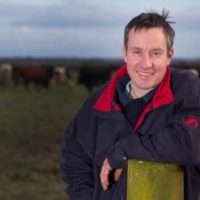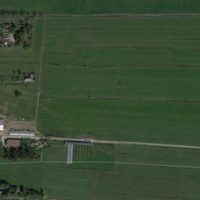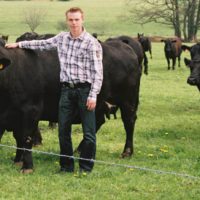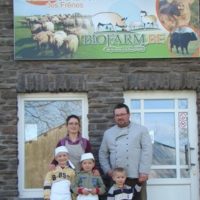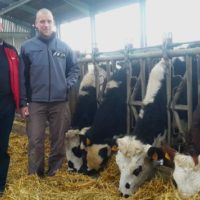Converting from beef to dairy farm
Farm: “Michael Doran”
Location: Johnstown, Duncormick, Co. Wexford, Ireland
Case study
 Converting from beef to dairy farm (.pdf)
Converting from beef to dairy farm (.pdf)
Description
Background
Michael Doran is quite a new entrant to dairy farming based at Johnstown, Duncormick, Co Wexford, just one mile as the crow flies from the sea. Michael had 135 cows when he joined the Teagasc Glanbia Monitor Farm Programme, he is now milking 240 cows.
When Michael’s father was growing up, his parents had a mixed farm with 12 cows all milked by hand, some sheep and tillage. They stopped milking cows in the 1950’s. Michael studied agricultural at Rockwell College finishing in 1994 and came home to farm full time. His father transferred over the running of the farm over a period of five or six years.
Michael’s heart was in the beef sector. He won Beef Student of the Year in Rockwell and his wife, Ciara, was a Beef Advisor with Teagasc.
Michael started with 50 suckler cows, 75 ewes and 12 hectares of cereals. He became a well known suckler farmer, working progressively to increase the suckler herd to 120 and sheep to 200, with 40 hectares of grain.
Michael researched further looking at the profits being made by good quality dairy farmers and felt it would be a logical decision at the time to switch from beef to dairy, as he believed it would offer better opportunity and profitability for his family, especially as milk quotas were being abolished.
“I had never milked a cow. But this was the best decision we ever made for the farm,’ says Michael. ‘From the profitability and financial point of view but also in terms of our lifestyle as a family.”
He and Ciara had a lot of contacts in Teagasc and spoke with advisors and researchers at Moorepark who gave them very valuable advice. In 2013 he applied for a milk quota under a new scheme for entrants and was originally allocated a quota of 200,000 litres.
Michael set about building a new 24-unit herringbone milking parlour, upgrading roadways on the farm and sold about 60 suckler cows to buy 80 in-calf Jersey cross heifers.
Michael put a lot of thought into the type of cow to have in his new herd. His decision to go with Jersey cross cows was supported by advice and research and was based on the their good track record in fertility, the solids these animals produce and that they can be easy to manage, which was a factor also in his first year in dairy farming. He also wanted to buy in from as few places as possible and managed to buy the first 80 in calf heifers from two farmers in October 2013. He milked his first cow in January 2014 and started supplying manufacturing milk to Glanbia Ireland.
Detailed description
Glanbia/Teagasc Monitor farm programme
Michael was asked to join the Teagasc Glanbia Monitor Farm Programme in 2015 and says it was a ‘brilliant’ decision. The joint programme set out to help dairy farmers promote sustainable growth post-quotas. Michael has found the experience very useful as he has had access to superb information and more people looking at what he is doing, feeding in to new ideas for the farm.
“It’s been fantastic. We’ve seen big improvements in a number of areas but the focus on finance and planning has been especially useful.”
Michael had 135 cows when he joined the Teagasc Glanbia Monitor Farm Programme but recognised that when he reached a herd size of 200 cows he would also be reaching the limit of what the farm could carry without having more land. In 2015 Michael purchased an adjoining 26 hectare block. He sold about 16 hectares of land five miles away from the milking platform and while the sale of the original land did not cover the full cost, the additional land increased the milking platform to 80 hectares.
Managing the costs of expansion
Michael continued to expand his herd by purchasing animals from as few herds a possible to minimise the risk of disease transmission. This year (2018) he is milking 240 cows.
Over the a three year period from 2013, Michael invested €309,500 on infrastructure alone including the new parlour/dairy, housing cubicles, storage and also work to bring the land bought from tillage into grass – this meant field infrastructure such as water, roadways and fencing.
‘The Monitor Farm Programme has given me a brilliant discipline about financial planning,’ says Michael. ‘Managing our finances has been crucial with this type of investment. We use the Cost Control Planner every year and have six year plans in place for the farm which are reviewed regularly. It has helped us to stay on top of our finances.
Michael has managed to reduce variable and fixed costs between 2014 and 2017. The overall net profit per cow has increased from 607 €uro per cow in 2014 to 936 €uro per cow in 2017.
Results
Making the grass system work profitably
Michael is a firm believer that having the right cow and getting grassland management right are two critical components of working the grass based system – “and converting money to my bank account”.
“I called myself a grass farmer before I called myself a beef or dairy farmer,’ says Michael. He has been measuring grass since 2008. Since getting involved with the Monitor Farm programme he has made further improvements in grazing the correct heights of grass and setting up the right paddock sizes.
Michael’s average milk yield in 2017 was 4,754 litres but he says that pushing big yields is not as important as improving solids and maximising production from grass. Average milk solids in 2017 were at 427 Kg, protein % at 3.87 and fat % at 4.85, with 55% of the herd first and second calvers.
In 2017 stocking rate was 2.85 (Lu/Ha). Michael was achieving 18 Kg DM/hectare grass growth but had also improved soil fertility with pH >6.3 at 85% in 2017 up from 20% in 2015. P Index 3/4 was up to 90% in 2017 from 65% in 2015; and K index 3/4 was at 95% in 2017 from 90% in 2015. He is doing soil testing every year to ‘keep a handle on it all.”
Managing a large herd
Michael appreciates he has learned a lot about managing a large herd through the Monitor Farm Programme but also describes his vet as a key member of his team. “We look at herd reports and plan together to make sure we have a good vaccination programme in place and that we are managing health as well as we can – preventing infection and minimising risks of any illness properly.
This year he tried Contract Rearing for the first time with 40 animals. ‘It did free up more time and made sure our stocking rates weren’t under pressure, especially when we faced conditions like drought.
Adoption criteria
- Lots of planning
- A grass based system
- A robust system to cope with low milk price years
- Soil fertility
- Reseeding programme
- Grassland measurement
Future prospects
Work & lifestyle balance
“Dairy farming needs a big commitment but I find I can manage it more efficiently than my previous beef enterprise.” says Michael. Previously he had about 13 groups of animals grazing and there was always something to do with so many groups of animals. Now he does his first milking at 7am and finishes the evening milking at about 5pm.
Michael now has two labour units working with him on the farm. Spring is always a busy time so the first five months they work every second weekend. When breeding is over this moves to everyone working every 3rd weekend so that he has more time with his family. He also manages to take a summer holiday in July each year, which would have been impossible on his previous beef enterprise.
Michael and Ciara have three children now – Ella aged ten, James aged six and Tomós is five. Both boys started primary school in September 2018, which is a big step. Michael hopes that one of them may be interested in the farm in the future but is determined that the farm that he passes on will be as good if not better than the farm he got from his parents. “That’s what family farming is really all about,” says Michael.
Additional information
| Farming system | conventional farming |
|---|---|
| Domains of innovation | farm system, grazing management system |
| Main types of animal | dairy cattle |
| Country | Ireland |
| Product type | Case study |
| Language | English |

